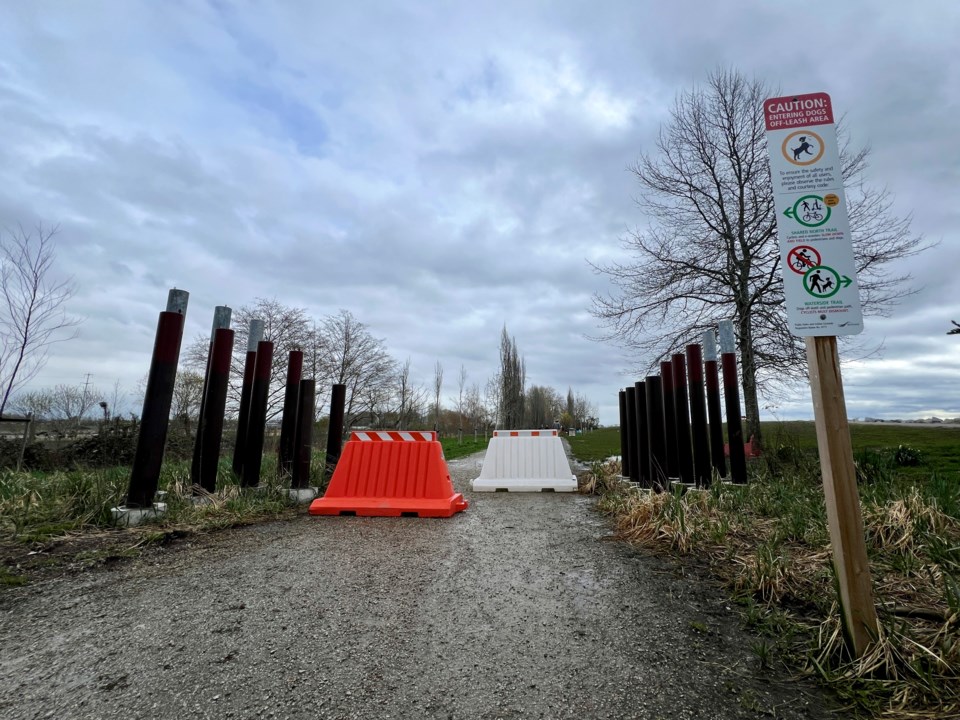Richmond community members are asking for temporary barriers at a local dog park to be removed immediately.
In mid-June, the City of Richmond set up temporary barriers on the lower and upper paths of Bark Park as a safety measure to slow down cyclists around the off-leash dog area.
However, the temporary barriers have been moved multiple times, completely blocking the Dyke Trail path, something observed by Richmond resident Judie Schneider.
Schneider started a petition to remove the barriers, collecting 93 signatures in just under two hours at the No. 3 Bark Park area on July 28.
Schneider and her partner Quinn Anderson are petitioning for the barriers on the riverside dyke trail beside the park to be removed so all users can immediately use the path.
"It is discriminatory, unfair and unreasonable for this public water access to be used solely by one group of citizens -- Bark Park users," reads the petition.
It further states the barricades should be around the "grass area only for the Bark Park."
"Dogs are chasing and nipping at pedestrians and cyclists who are trying to use the (dyke) for their enjoyment on public land that has always been a throughway to get to Finn Slough and other areas east of the Bark Park."
Schneider told the Richmond News that, while barriers were put in place in good faith to slow down fast-moving cyclists travelling through the park, they have been constantly moved by "a core group of dog walkers" making it appear the path is completely blocked and inaccessible.
"The barricades are continuously moved so close together that wheelchairs, strollers and bikes cannot get through," she said.
"(This group)'s main beef is with cyclists coming through there, but it's a shared path and a public route."
Schneider, who often cycles around the city with her son, added the barricades send a message to the public that the area is "off-limits" to people other than users of the off-leash dog park.
The sight of the closely placed barricades makes the path look like "a construction zone" and unusable, she added.
"Why one small group of citizens should be granted access to this section of the dike and not others is a public outcry and needs to be rectified immediately."
City spokesperson Clay Adams said the city is aware some people are moving the temporary barriers "in an effort to restrict access."
"City Parks staff are monitoring the situation and looking at ways to reduce the ability of people to move them," said Adams.
"We remind everyone that these are only temporary and will be removed once permanent fencing and gates are added."
Adams highlighted the barriers were a temporary solution to help slow down cyclists and "deter them from using the dyke trail" in response to safety concerns by park users.
Everyone who uses the park, he added, is encouraged to be respectful of the space and each other.
City staff are designing and planning the permanent site enhancements for Bark Park with work expected to start in the coming weeks and finish by the end of the year, according to Adams.
"Key to that timeline is an environmental and engineering consultation to make sure that any work carried out will not negatively impact the watercourse, nearby bird nests or the integrity of the dyke," he said.
Richmond city council approved the changes to No. 3 Road Bark Park on June 10 including installing fences and gates on the east and west sides of the park, according to city documents.
Signage marking the cycling path in Bark Park as well as upcoming projects were also added in the area.
Got an opinion on this story or any others in Richmond? Send us a letter or email your thoughts or story tips to [email protected]. To stay updated on Richmond news, sign up for our daily headline newsletter. Words missing in article? Your adblocker might be preventing hyperlinked text from appearing.



